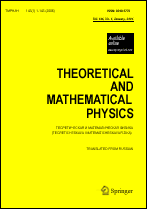|
This article is cited in 29 scientific papers (total in 29 papers)
A matrix model for hypergeometric Hurwitz numbers
J. Ambjørnab, L. O. Chekhovcde
a Niels Bohr Institute, Copenhagen University, Copenhagen Denmark
b IMAPP,
Radboud University, Nijmengen, The Netherlands
c Steklov Mathematical Institute, RAS, Moscow, Russia
d Laboratoire Poncelet, Independent University of Moscow, Moscow, Russia
e Center for Quantum Geometry of Moduli Spaces,
Århus University, Århus, Denmark
Abstract:
We present multimatrix models that are generating functions for the numbers of branched covers of the complex projective line ramified over $n$ fixed points $z_i$, $i=1,\dots,n$ (generalized Grothendieck's dessins d'enfants) of fixed genus, degree, and ramification profiles at two points $z_1$ and $z_n$. We sum over all possible ramifications at the other $n-2$ points with a fixed length of the profile at $z_2$ and with a fixed total length of profiles at the remaining $n-3$ points. All these models belong to a class of hypergeometric Hurwitz models and are therefore tau functions of the Kadomtsev–Petviashvili hierarchy. In this case, we can represent the obtained model as a chain of matrices with a (nonstandard) nearest-neighbor interaction of the type $\operatorname{tr} M_iM_{i+1}^{-1}$. We describe the technique for evaluating spectral curves of such models, which opens the way for obtaining $1/N^2$-expansions of these models using the topological recursion method. These spectral curves turn out to be algebraic.
Keywords:
Hurwitz number, random complex matrix, Kadomtsev–Petviashvili hierarchy, matrix chain, bipartite graph, spectral curve.
Received: 11.09.2014
Citation:
J. Ambjørn, L. O. Chekhov, “A matrix model for hypergeometric Hurwitz numbers”, TMF, 181:3 (2014), 421–435; Theoret. and Math. Phys., 181:3 (2014), 1486–1498
Linking options:
https://www.mathnet.ru/eng/tmf8791https://doi.org/10.4213/tmf8791 https://www.mathnet.ru/eng/tmf/v181/i3/p421
|


| Statistics & downloads: |
| Abstract page: | 522 | | Full-text PDF : | 164 | | References: | 45 | | First page: | 13 |
|




 Contact us:
Contact us: Terms of Use
Terms of Use
 Registration to the website
Registration to the website Logotypes
Logotypes







 Citation in format
Citation in format 
